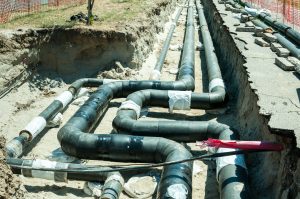Ahead of the major decarbonisation challenge in the UK, Nick Geddes, Energy Systems Catapult, explores how cost-effective, sustainable alternatives such as heat networks could be the solution
Three in four households in England and Wales use mains gas to heat their homes.
Since the 1960s, heat networks (also known as district heating) have played a minor role in heating our homes and buildings.
Today, however, these networks serve over 480,000 consumers right across the UK. This number is expected to increase exponentially. By 2050, it is estimated that one in five homes could be heated by a heat network.
Protecting consumers from the get-go
It’s not enough to simply roll out technology and hope that consumer protections are applied along the way. We need to ensure that – from the off – customers have comparable protections to those who get their heat and power from the grid.
They must be the central pillar in network regulation. There’s a particular need to suitably protect those on low incomes and in vulnerable situations.
The way to achieve this is to establish an appropriate regulatory framework that introduces statutory rights for consumers and obligations for market participants that reflect the potentially monopolistic characteristics of heat networks.
The UK government’s Energy Security Bill (currently making its way through Parliament) is expected to lay the foundations for such a framework by granting Ofgem the role of heat network regulator.
A new regulatory challenge
It’s not yet clear how prepared Ofgem is to take on this regulatory role. As our co-authored report Heat Networks: Consumer Protection Regime with Vattenfall makes clear, heat networks present a different regulatory challenge compared to the electricity and gas networks and energy retailers that Ofgem is used to overseeing.
For example, there are over 14,000 heat networks in the UK varying significantly in size, ownership, consumer characteristics and technology used. Now, compare this to the 14 electricity and gas network operators that Ofgem currently regulates. The scale of the challenge is not insignificant.
Ofgem and the wider heat network industry have an opportunity to build a framework that learns the lessons of the gas and electricity markets.
These lessons should be applied to heat network regulations to make a holistic, consumer-centric heat network market that prioritises fair pricing, a reliable heat supply and support for vulnerable customers while spurring innovation.

A hybrid model of regulation
Initially, we’d expect Ofgem to rely more on a rules-based approach, helping to communicate clear expectations to heat network operators, particularly when regulation relates to consumers on a low income or in vulnerable situations.
But as the sector matures and Ofgem settles into its newly minted role, we would expect to see a greater reliance on principles as opposed to strict rules-based governance.
This kind of evolving hybrid model of regulation – combining both rules-based and principles-based approaches to regulation – could yield the optimal model, allowing for innovative ideas, services and solutions to better deliver for consumers.
As the regulatory regime and market evolve, a proportionate approach is favourable to help ensure participants and infrastructure have time to respond to the new regulatory regime and to ensure further facilitation of innovation and market development.
This includes, for example, data best practice and innovative methods to address fuel poverty and vulnerable consumers, including social tariffs.
To that end, specific and measurable outcomes are required to help provide heat network suppliers with clarity of what is expected of them. These outcomes should be supported by minimum technical and operating license conditions.
Data-driven confidence
Data will undoubtedly play an important role in making sure that the regulatory environment is functioning properly. Additionally, data can provide consumers, heat network operators, and Ofgem with the confidence that desired outcomes are being met – and will also provide an indication of where regulatory intervention is needed.
Heat network operators will ultimately need to get better at sharing data with the regulator, and the approach to regulation should be aligned with existing and future technical standards. Data should be put to its fullest use, and principles used to ensure it supports consumer protection outcomes, including vulnerability, ability to pay and technical performance assessments.

It’s up to the industry to deliver heat networks
Heat networks will be central to the transition to net zero by 2050. In our haste to roll heat networks out, however, we should not lose sight of the end consumer. We have an opportunity to position consumers as the central pillar in the rollout of heat networks, helping to ensure that their needs are met.
It’s now up to the industry to make sure that the customer’s experience of being on a heat network is a good one.
Nick Geddes
Business leader – whole systems & networks
Energy Systems Catapult
Tel: +44(0)121 203 3700

















